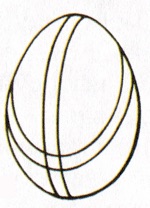Diagonal Division


This division is created, generally, by first dividing the egg into two with a longitudinal band, and then writing a diagonal band on each face of the pysanka. Most commonly, the diagonal band is continuous, in that it travels down one side of the egg, and up the other side; i.e. the two faces are mirror images of each other. You can sometimes see the opposite: the diagonal band is discontinuous, with identical bands being seen on both faces of the pysanka (see Балан 16, 59).
The longitudinal dividing bands are, with rare exception (e.g. Балан 176), usually present. They vary from two simple parallel lines (usually with an Easter greeting written in between them, e.g. «Христос Воскрес!»), to lines with very simple designs within them, and to highly ornamented bands. You can see the range of possibilities below.
The motifs are usually similar to those found in the central bands of barylky; each diagonal band is normally divided into a number of squares, which then contain identical or regularly alternating motifs. In many cases, there will be smaller decorative bands above and below the main diagonal band (as is often seen with barylky), or a section of wave-form bezkonechnyk (see Балан 16, 53).
The angle of the diagonal varies a lot, too. Some are at a 45° angle (or greater) to the equator, similar to the band shown in the Binyashevsky aquarelle above; others barely arise above the equator, and are simply a bit inclined.
The ornamentation of the lunettes (half moon spaces) above and below the diagonal band varies significantly. On pysanky which have multiple diagonal bands (primary and secondary), this space may be quite small and be left empty, or contain merely a few dots (see Балан 8 or 16 below). In others there can be various forms of ornamentation, including pine boughs (Балан 59), fish (Балан 156), or stalks of wheat (Балан 99).
As noted above, most diagonal pysanky have a longitudinal dividing bands, but some do not. (Examples include Балан 176, 262, 288, 294, 320, 323, 379 and 424 below.) This type of pysanka usually has an end motif, most commonly a star or flower. Those pysanky with multiple, complex bands may leave the end space free (e.g. Балан 294); those with very simple bands may have an intricate end motif, as in Балан 424, whose end motif is a complex cross.
Perusing the pysanky below, you can’t help but be struck by the amount of variation possible in such a simple division. After all the diagonal division is, essentially, just a barylka tipped a bit to the side and with a ring around it.
(I have included multiple views of each of the pysanky to make reproducing them easier. If you do re-create any of these pysanky, send me a photo!)
(Note: the numeration of these eggs, i.e. the “Балан - №,” simply reflects the order in which they were photographed and their data recorded. It is just my bookkeeping system.)
Pysanky at an Angle

Back to Bukovyna Home
Back to Carpathian Pysanky Home
Back to Regional Pysanky Home
Back to Traditional Pysanky HOME
Search my site with Google





